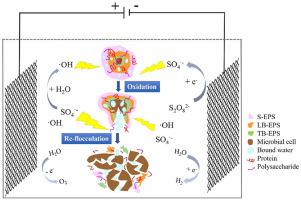Journal of Environmental Management ( IF 8.0 ) Pub Date : 2021-07-26 , DOI: 10.1016/j.jenvman.2021.113342 Guanjun Wang 1 , Dongdong Ge 1 , Lu Bai 1 , Yanting Dong 1 , Chang Bian 1 , Jiajia Xu 1 , Nanwen Zhu 1 , Haiping Yuan 1

|
Sludge dewatering, as one of the most important steps of sludge treatment, can facilitate transportation and improve disposal efficiency by reducing the volume of sludge. This study investigated the effects of electrolysis-activated persulfate oxidation on improving sludge dewaterability. The results indicated that the sludge capillary suction time (CST) and water content of dewatered sludge cake (Wc) reduced from 93.7 s and 87.8% to 9.7 s and 68.3% respectively at the optimized process parameters: electrolysis voltage of 40 V, electrolysis time of 20 min, and 1.2 mmol/g TS S2O82−. Correlation analysis revealed that the enhancement of sludge dewaterability was closely associated with the increased floc size and zeta potential, decreased protein content in three-layers extracellular polymeric substances (EPS) and viscosity (R = −0.868, p = 0.002; R = −0.703, p = 0.035; R ≥ 0.961, p < 0.001; R = 0.949, p < 0.001). Four protein fluorescence regions in EPS were analyzed by three-dimensional excitation-emission matrix parallel factor (3D-EEM-PARAFAC). The protein secondary structure was changed after the treatment, and the reduction of α-helix/(β-sheet + random coil) indicated that more hydrophobic sites were exposed. Analysis by X-ray photoelectron spectroscopy (XPS), Fourier transform infrared (FTIR) and rheological test demonstrated that the hydrophilic functional groups of the sludge were decreased and the sludge mobility was significantly enhanced after the treatment with electrolysis-activated persulfate oxidation. Moreover, bound water was converted to free water during SO4·− and ·OH generated by electrolysis-activated persulfate degraded EPS and attacked sludge cells. Meanwhile, scanning electron microscopy (SEM) images revealed that the treated sludge formed porous channel structures, which promoted the flowability of the water. These findings provide a new insight based on electrolysis-activated persulfate oxidation in sludge treatment for enhancing sludge dewaterability.
中文翻译:

深入了解电解活化过硫酸盐氧化在废弃活性污泥脱水性能中的作用:效应和机制
污泥脱水作为污泥处理最重要的步骤之一,可以通过减少污泥量来方便运输和提高处置效率。本研究调查了电解活化过硫酸盐氧化对提高污泥脱水能力的影响。结果表明,在优化的工艺参数下:电解电压40 V,电解时间,污泥毛细管吸入时间(CST)和脱水污泥饼含水量(Wc)分别从93.7 s和87.8%降低到9.7 s和68.3% 20 分钟,和 1.2 mmol/g TS S 2 O 8 2−. 相关性分析表明,污泥脱水能力的提高与絮体大小和zeta电位的增加、三层胞外聚合物(EPS)中蛋白质含量和粘度的降低密切相关(R = -0.868,p = 0.002;R = -0.703 , p = 0.035; R ≥ 0.961, p < 0.001; R = 0.949, p < 0.001)。EPS中的四个蛋白质荧光区域通过三维激发-发射矩阵平行因子(3D-EEM-PARAFAC)进行分析。处理后蛋白质二级结构发生变化,α-螺旋/(β-折叠+无规卷曲)的减少表明更多的疏水位点暴露。X射线光电子能谱(XPS)、傅里叶变换红外(FTIR)和流变测试表明,经过电解活化过硫酸盐氧化处理后,污泥的亲水性官能团减少,污泥流动性显着增强。此外,结合水在 SO 4 · -过程中转化为自由水电解活化过硫酸盐产生的·OH降解EPS并攻击污泥细胞。同时,扫描电子显微镜(SEM)图像显示,处理后的污泥形成了多孔通道结构,促进了水的流动性。这些发现提供了基于电解活化过硫酸盐氧化在污泥处理中提高污泥脱水能力的新见解。











































 京公网安备 11010802027423号
京公网安备 11010802027423号